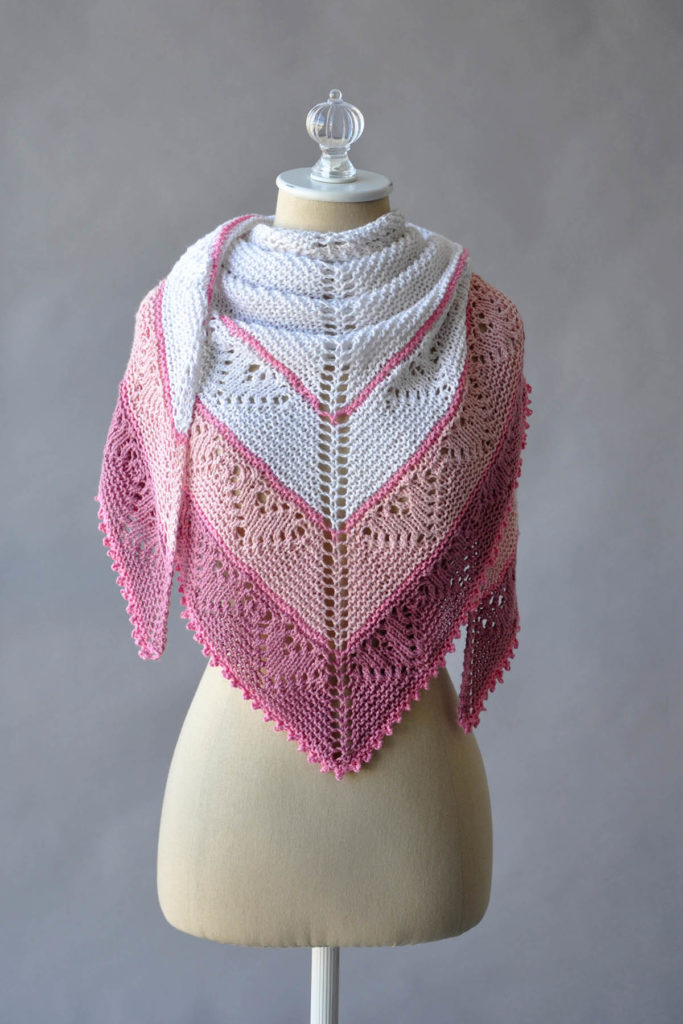
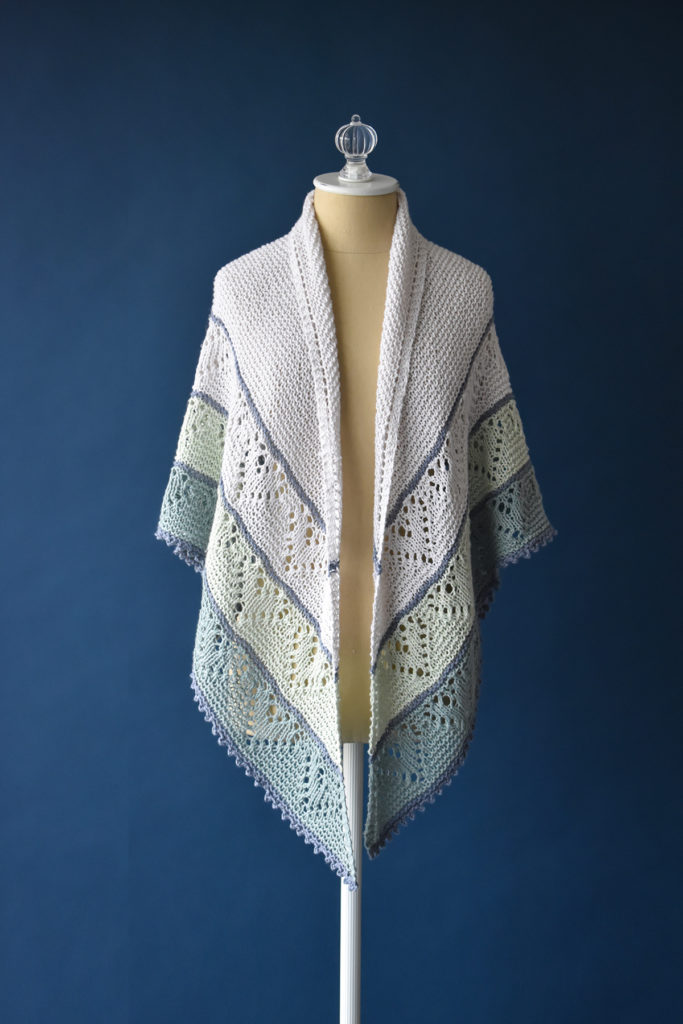
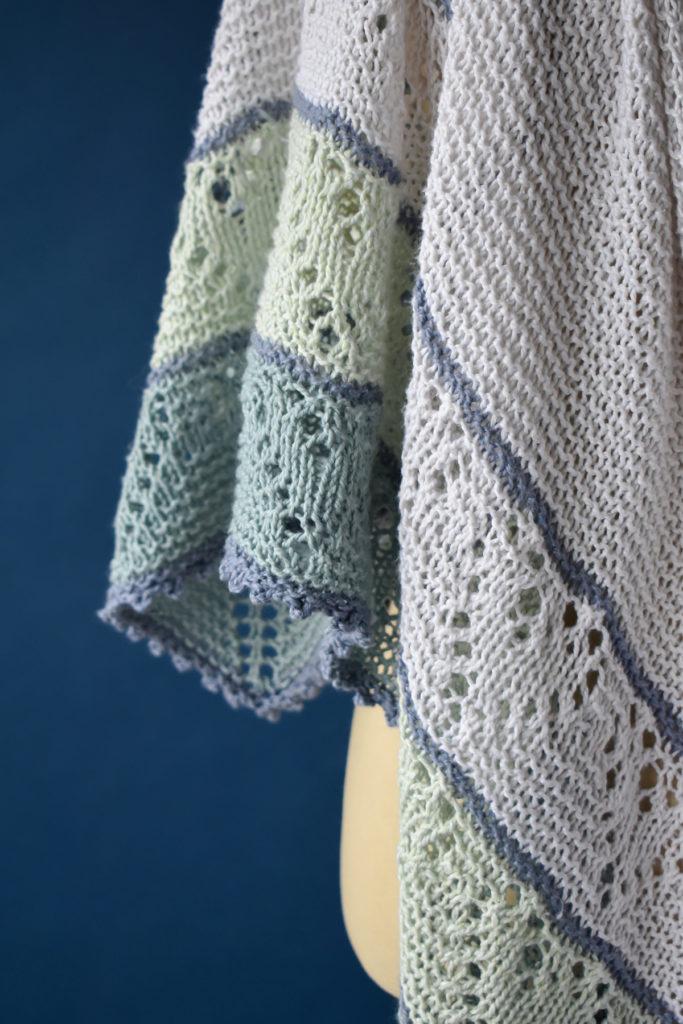
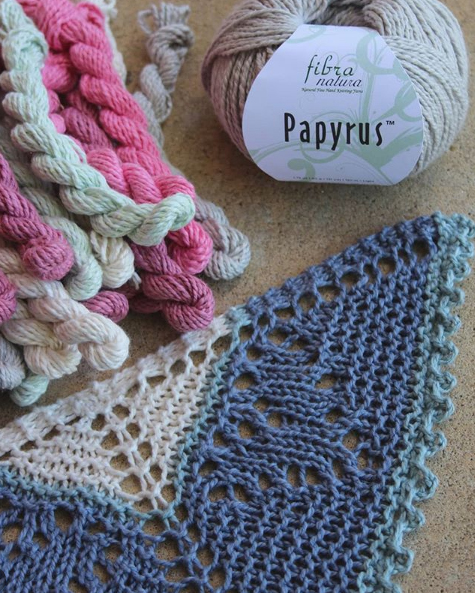
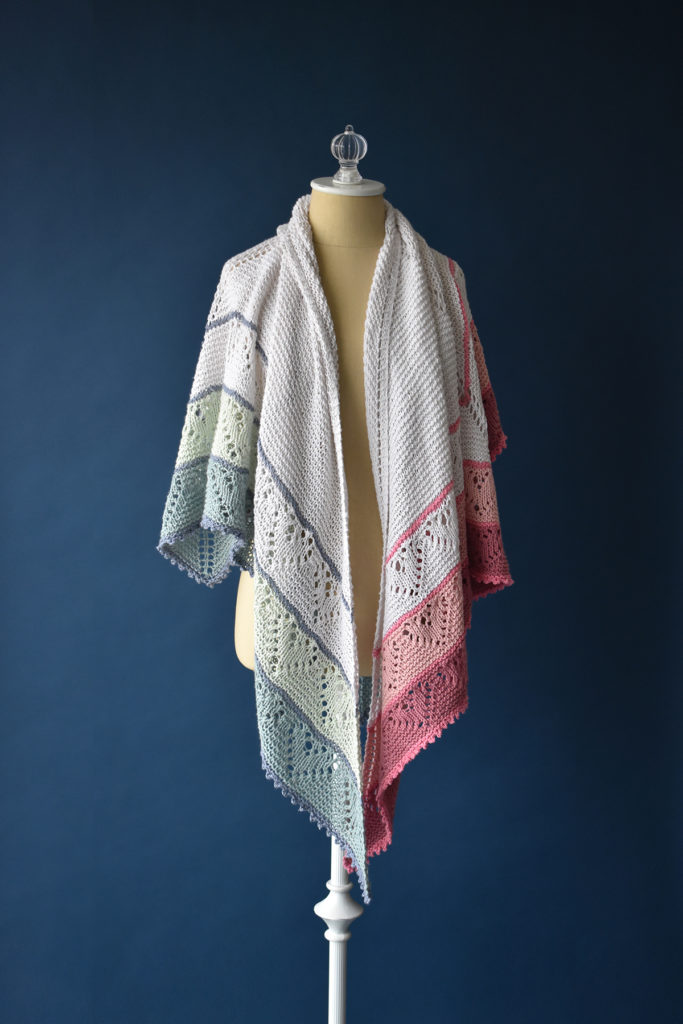
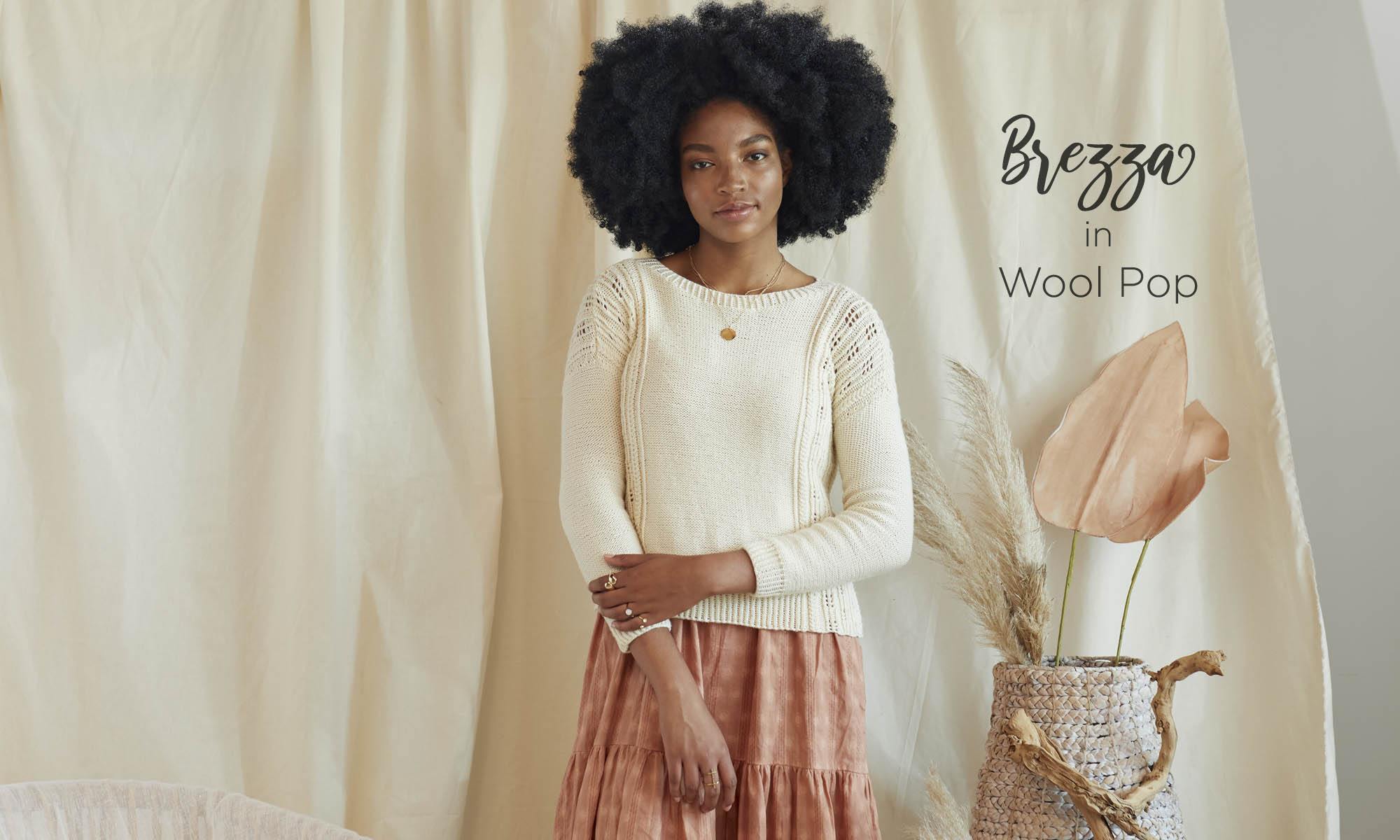

Universal Yarn Creative Network
Inspiration By Design





Seasons Greetings from the Universal Yarn Team! Today, we’re pleased to share a special free pattern with you for the Christmas season: the Carolina Holly hat (pattern link)! Holly – like poinsettias, mistletoe, and ivy – conjures images of the holidays. The spiky plant is evergreen and beautiful, and it was the inspiration for the Carolina Holly hat.
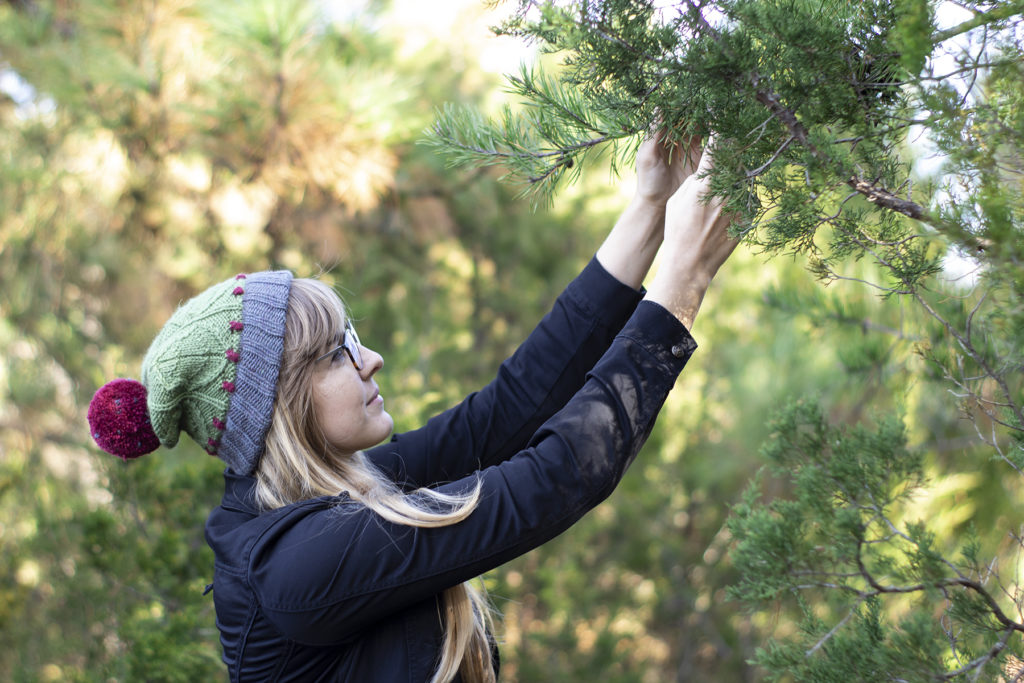
This free pattern is a load of fun to knit. It takes three skeins of Deluxe Worsted – and that’s enough to make two hats. Of our line of yarns, Deluxe Worsted might just be my favorite. It’s excellent for every type of project, creates long-wearing fabric, and perfectly balances softness with the crunch of pure wool that I love. Plus, there are so many colors to choose from. For this hat I chose Sangria, City Turf, and Slate, but there are so many shades of red, green, and grey in the palette. I encourage you to find the combination that leaves you feeling inspired! Prefer superwash wool? You’re in luck – our machine-washable Deluxe Worsted Superwash would work perfectly as a substitute.
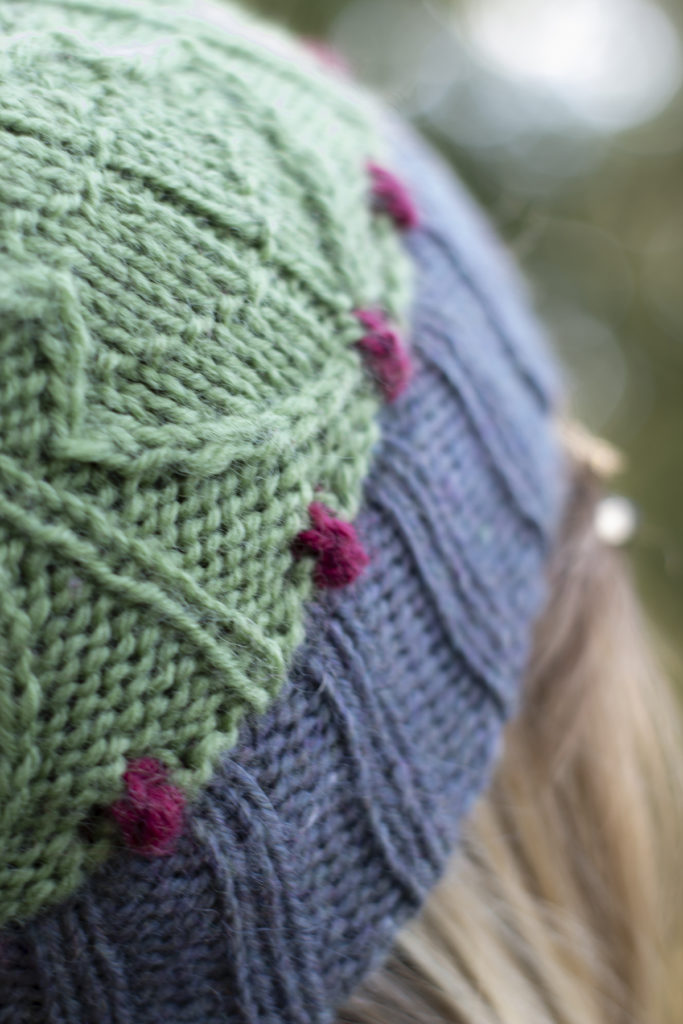
I wanted to give this hat some special touches. A double-thick brim ensures a warm and comfortable fit. A row of mini-bobbles knit in a rich red create little holly berries, and a large red pom-pom balances out the pop of red. Finally, to incorporate the grey used in the brim, the same color is used to add speckles to the pom-pom. The speckled pom-pom idea was not my own. I was inspired by designer Kiyomi Burgin, who has used this technique in her own work. You can find her post on speckled pom-poms here (link).

For your convenience, I’ve also created a tutorial. I hope you find it to be helpful! You’ll need to make your pom-pom before starting. If you haven’t done this before, don’t worry! You can find Amy’s tutorial on how to make pom-poms here (link).
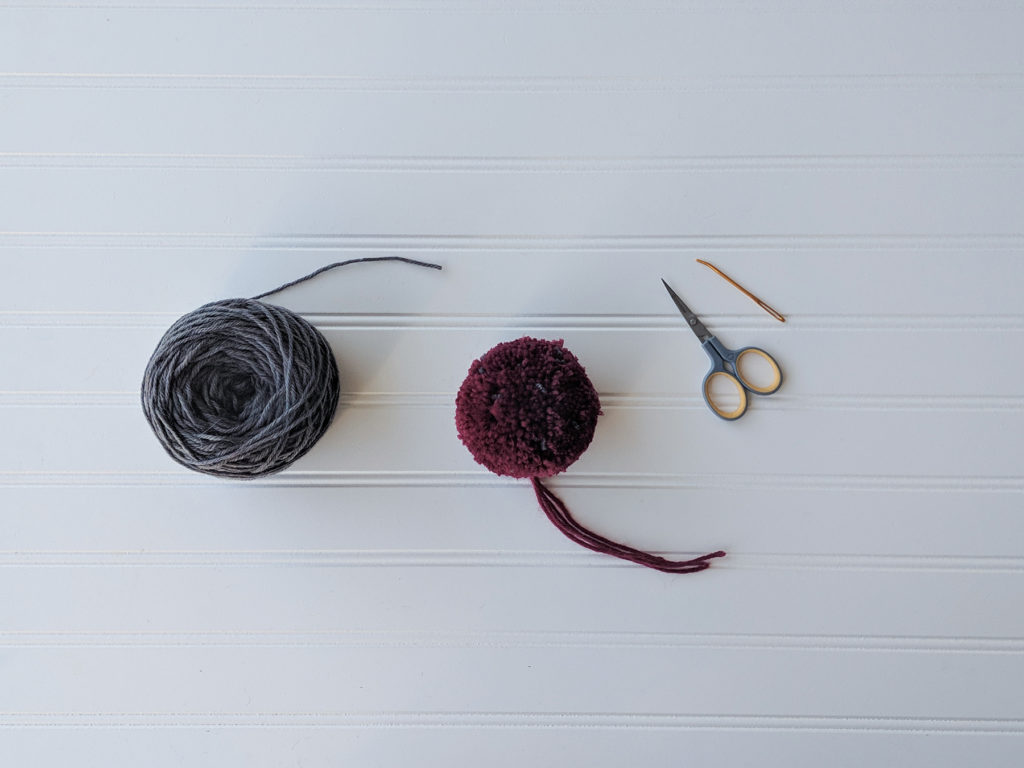

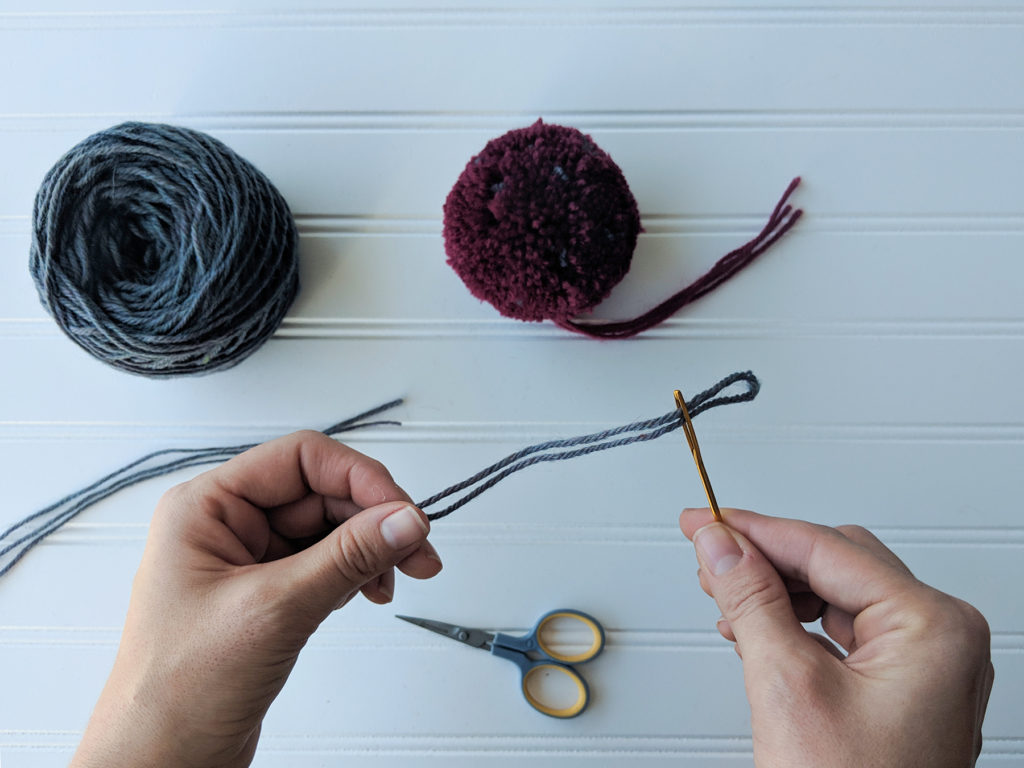
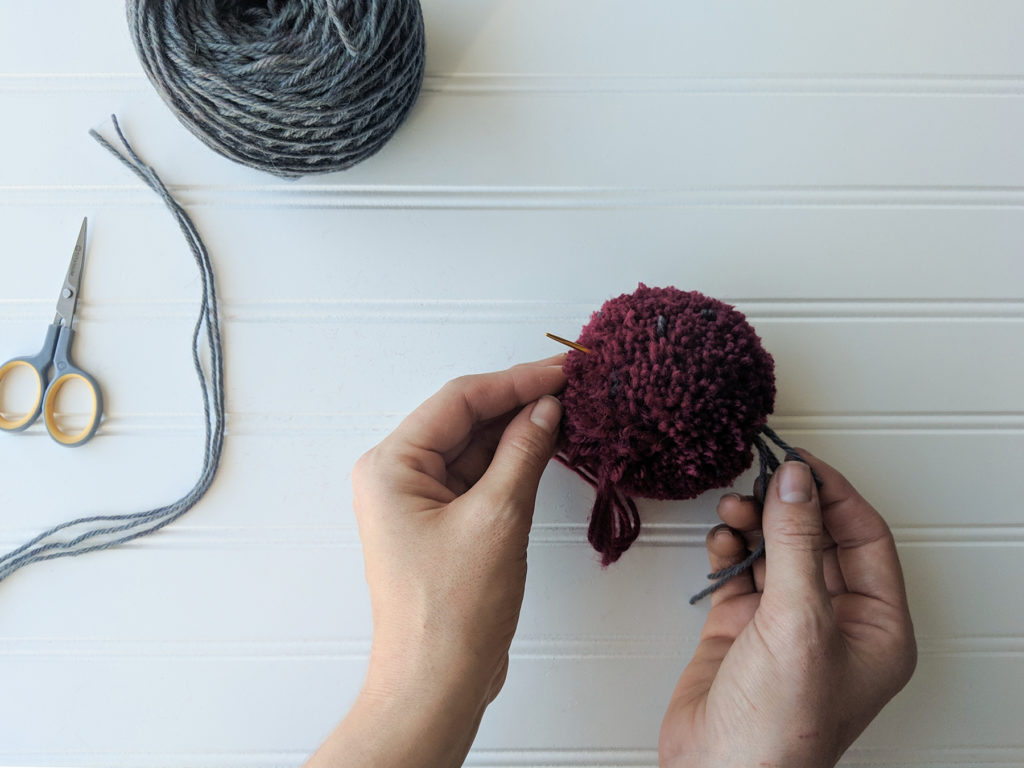
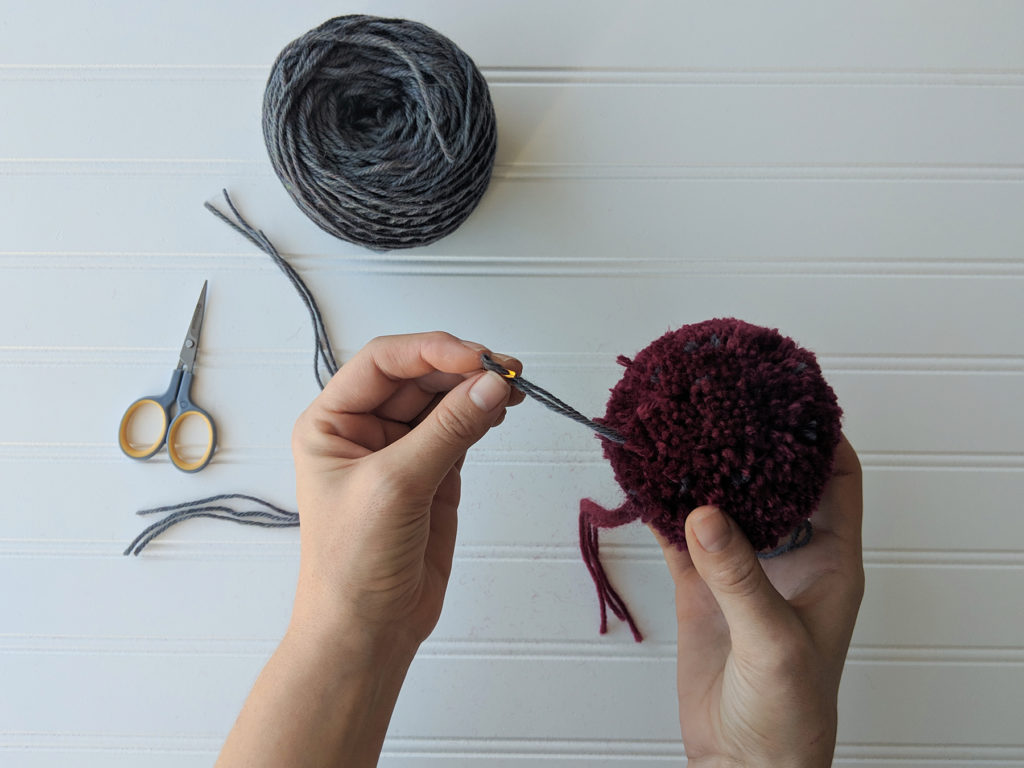
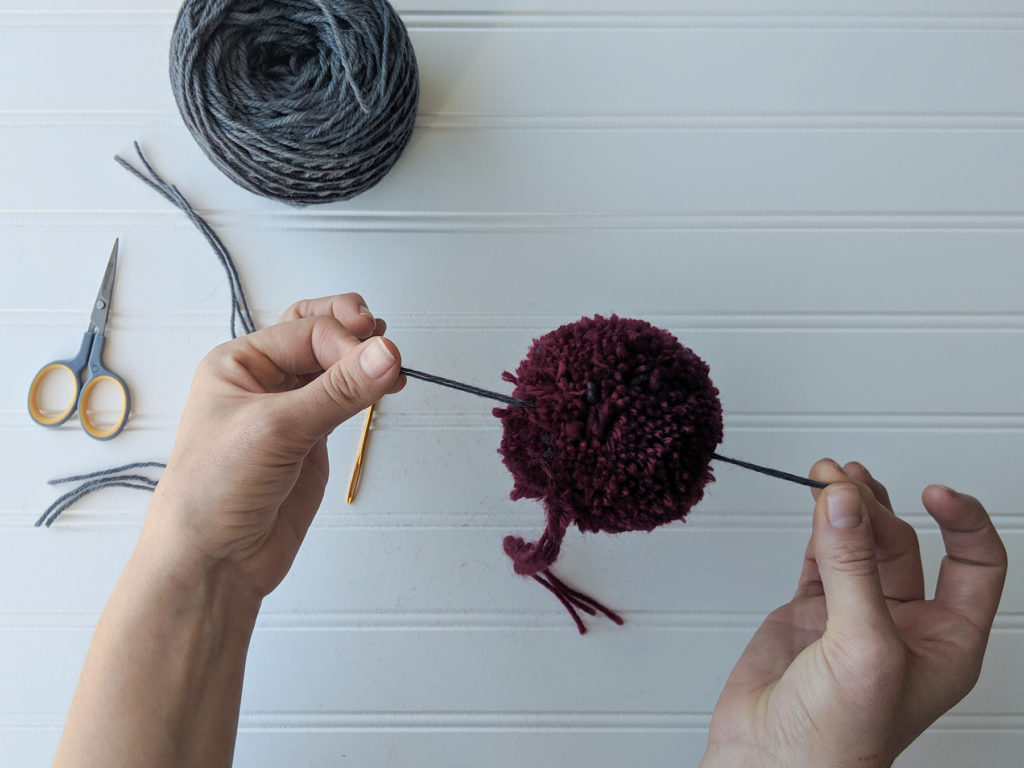
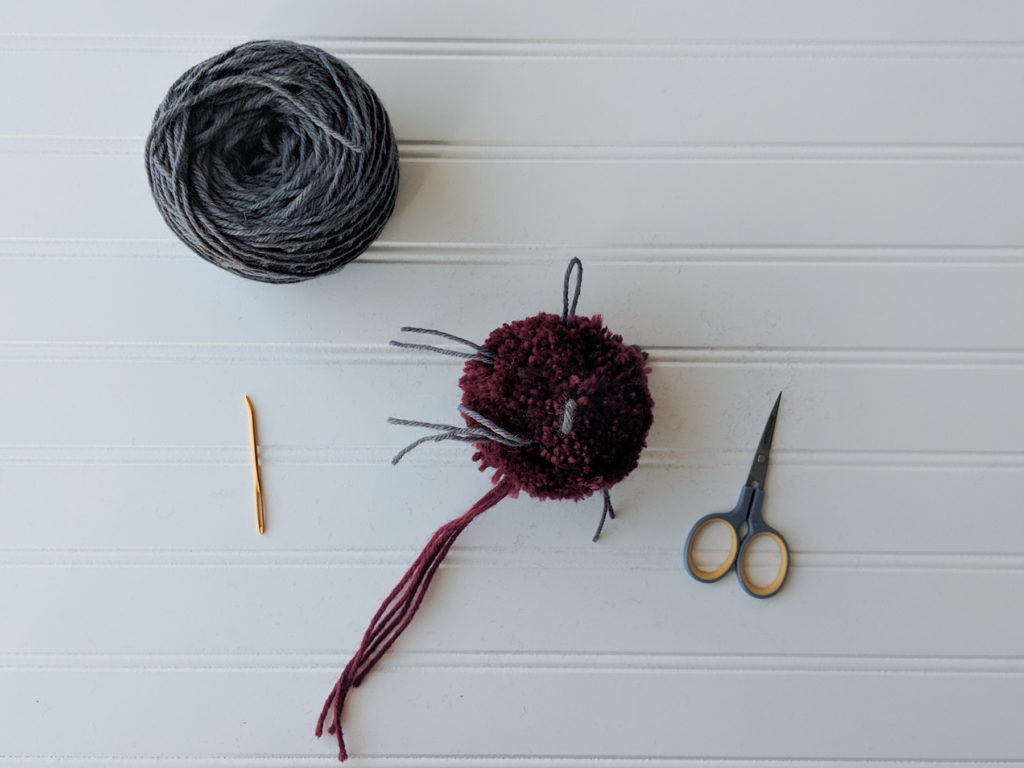

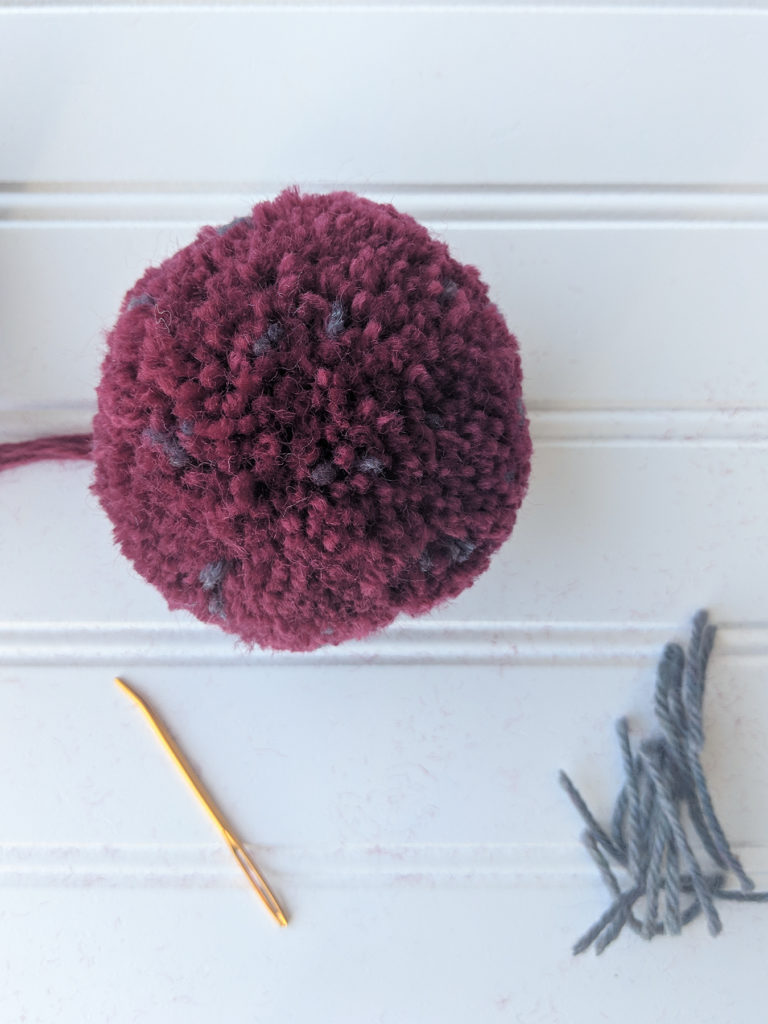
Giving back: it’s something everyone seems to think more about this time of year, and something we could all probably think about a bit more. That’s why we have created the new pattern, Thy Neighbor (pattern link).
 Thy Neighbor – A pattern to benefit the Refugee Support Services center in Charlotte.
Thy Neighbor – A pattern to benefit the Refugee Support Services center in Charlotte.
We recently began donating some of our time and resources to the RSS: Refugee Support Services here in Charlotte, the city Universal Yarn calls home. This organization is doing amazing things, and we want to support them in every way we can.
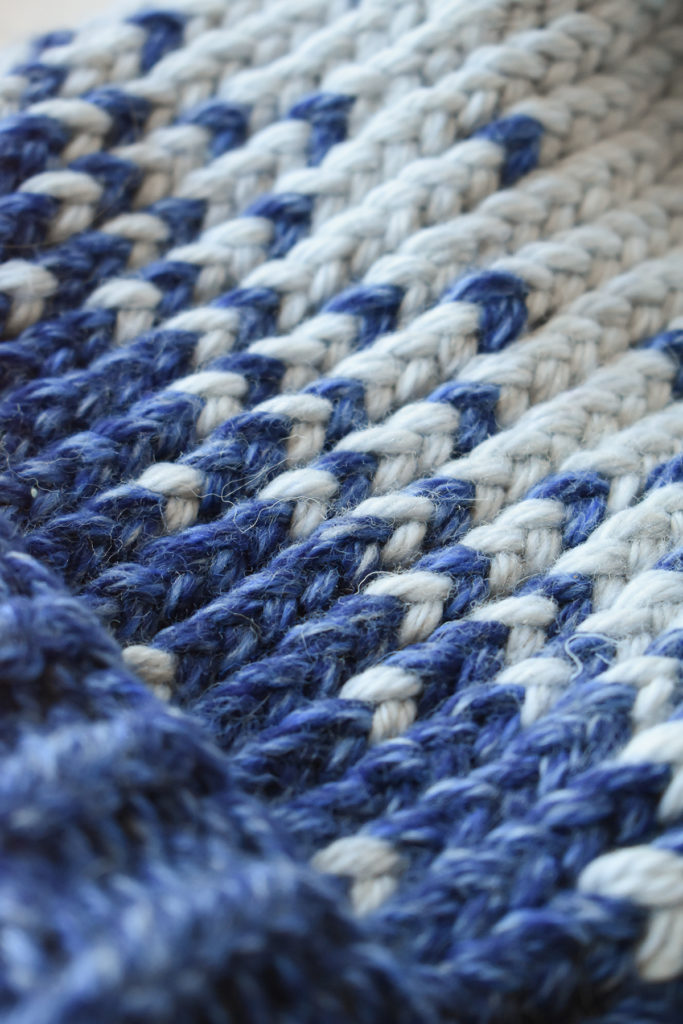
Each Thursday, a group of wonderful women and volunteers meet at the center for English lessons, knitting, community-building, and to take advantage of the many resources the facility has to offer.
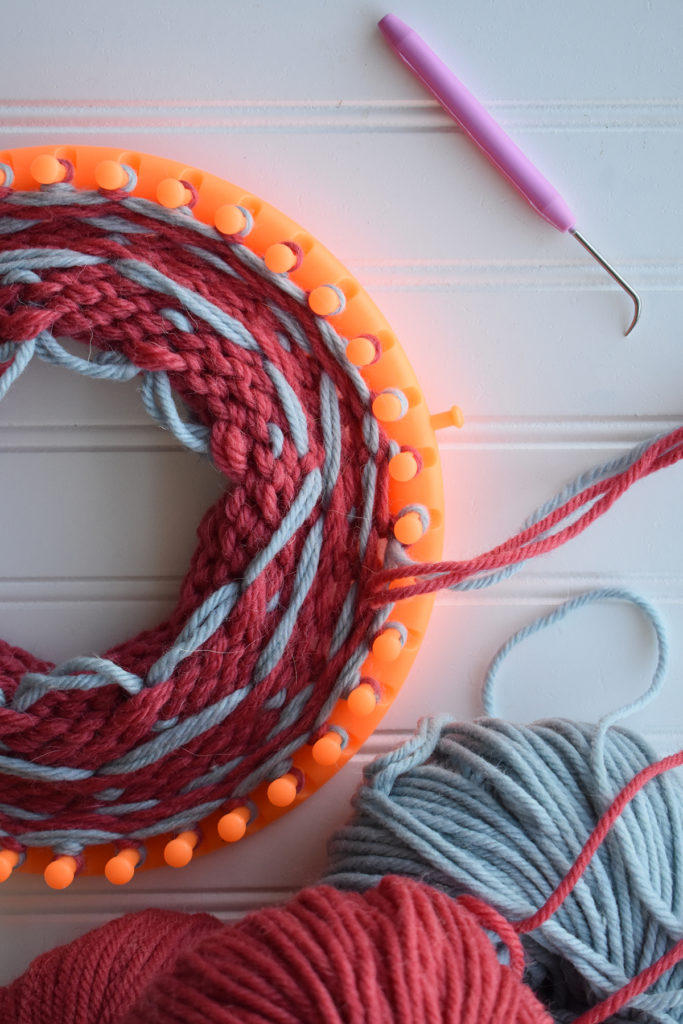
Many of the women make hats on round knitting looms. Loom knitting is really accessible. Anyone can pick it up in just a few minutes, which might be why it’s a popular knitting method at the center. Although we had never knit using looms before, we wanted to meet participants where they are. So we got some looms to practice and will now contribute our own knowledge of knitting. Volunteers at the center help the women distribute their handcrafted goods to earn extra income and develop financial literacy. As a way to give back and support their efforts, we designed this Fair Isle hat. We’ll be teaching the participants this technique to spice up their loom-knitting activities. All proceeds from the sale of this pattern will be donated back to RSS.
As I said before, we want to do as much as we can for this organization. It brought us so much joy to sit in a room filled with the chatter of people from all over the world, offering a helping hand, and exchanging kindness with one another. It’s truly special. When you purchase Thy Neighbor, 100% of the proceeds will be donated to RSS. Financial contributions to the organization help make their peer support, educational, legal, and social programs possible. We sincerely hope you’ll join us in helping, and encourage you to explore the RSS website (link) to deepen your understanding of their work.
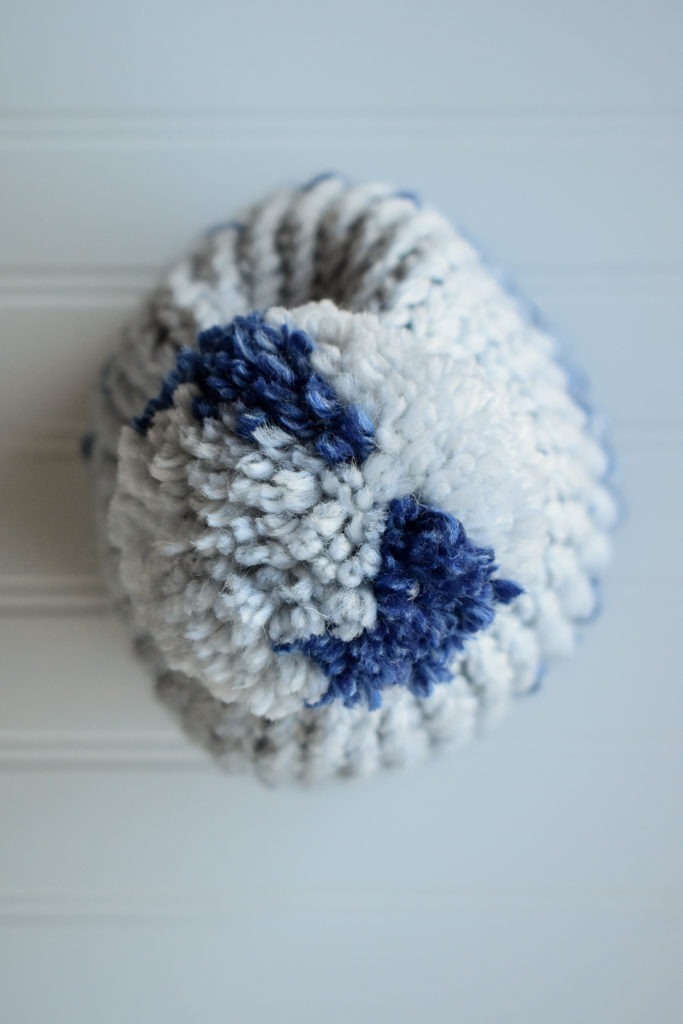
Thank you so much for joining us in our support of RSS! We hope you have a wonderful week!
It’s Free Pattern Friday!
Today, the Contours Cowl in Alaska (pattern link here).
The Contours Cowl features lofty, all-over cables. If you thought cables make for a dense fabric, think again – Alaska is featherweight and soft as down, countering the density you might expect from the usual cabled cowl. It’s perfect to loop around your neck once or twice – and each styling option will keep you warm and cozy.
Knit seamlessly from the bottom-up, this cowl features an easily memorizable cable and slip stitch pattern on a background of reverse stockinette.
We hope you enjoy this week’s free pattern! Have a wonderful, craft-filled weekend!
Today is Thanksgiving – since it is a national holiday in the United States, many of us will be spending the day with friends and family. Not only is today Thanksgiving, but November is also Native American Heritage Month. As such, I’m taking some time to talk about the incredible textile work of indigenous Americans.
Disclaimer: this is in no way a comprehensive overview. I am touching on only a few things. I could go on for much longer than I will, and I’ll happily include some information for further reading.
When I initially decided to use today’s post as a platform to touch on Native American Heritage Month, my brain went to knitting – it always does. I wanted to look into traditional Cowichan sweater knitting. Okay – I know we’re based in the US, and that today is a US holiday, but the first tradition I’d like to talk about originates in Canada. Anyway – these iconic sweaters originate from the Coast Salish people of British Columbia.

During the mid-nineteenth century, European settlers introduced domestic sheep and the craft of hand-knitting to the region. In an excellent overview of the history of Cowichan Knitting (pdf link), Margaret Meikle explains that native women skilled in handcrafts likely taught themselves to knit, working from samples available to them from the European settlers. Although the first Cowichan sweaters were solid-colored, Fair Isle sweaters influenced the colorwork these sweaters are known for early in the twentieth century.
In her book Knitting Around the World, Lela Nargi explains that the yarn used to create these sweaters as thick, handspun, single-ply, and naturally colored. These sweaters are as utilitarian as they are attractive. They are hardy and perfect to withstand cold, wet climates. They also feature beautiful patterning – each symbol with a story behind it.
In the children’s book, Yetsa’s Sweater (pictured above), author Sylvia Olsen demonstrates how the sweaters are personal. In the book, Yetsa’s grandma explains that the sweaters tell a story about family. I’d recommend checking out this book if you’re looking to share your love of knitting with young people in your life, but there is no shame in reading it as an adult!

If you now find yourself dreaming of a Cowichan-style sweater, I also discovered that Sylvia Olsen also wrote Knitting Stories, a book featuring Salish-inspired designs including Yesta’s Bolero – a perfect match for Deluxe Worsted Naturals (Pewter and Millet, anyone?). There are many interpretations of Cowichan sweaters on Ravelry. One in particular I like is Jane Richmond’s West Coast Cardigan – which she describes as being “inspired, in respectful admiration, by the Cowichan Sweaters that are abundant on Vancouver Island and are a tradition of the Coast Salish people” and clarifies that the design is not a real Cowichan sweater, only inspired by this traditional style. For her design, I’d recommend holding two strands of Deluxe Chunky Naturals together as one to obtain gauge.
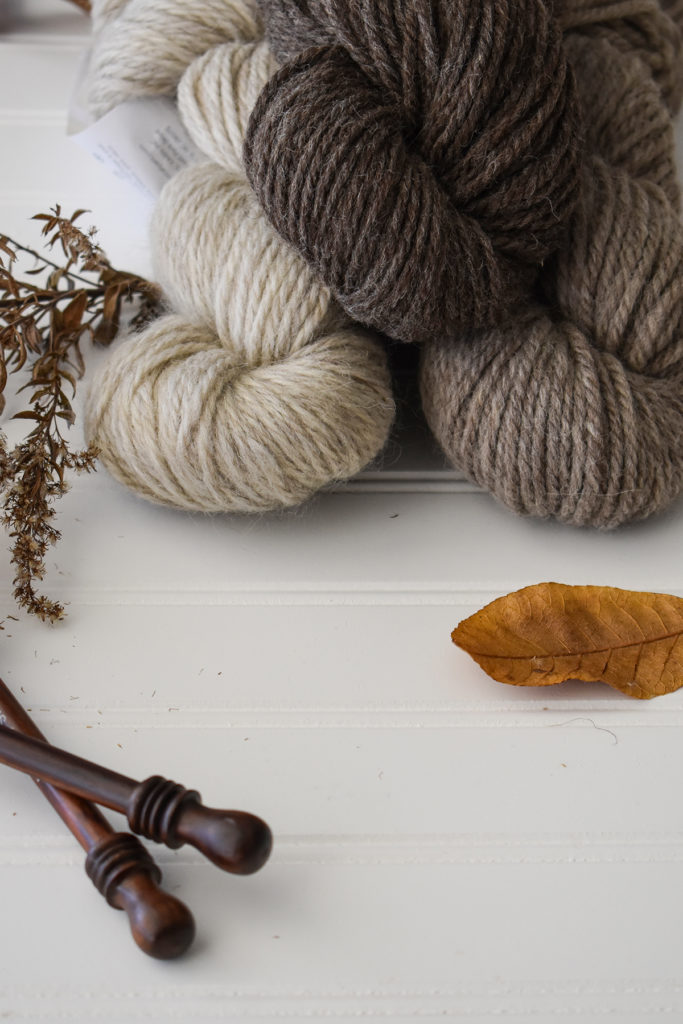
Next, I’d like to touch on weaving.

In Alaska, the Tinglits Chilkat people created beautiful Chilkat blankets. Made for movement, these blankets feature long-fringed borders that swayed beautifully with the dancers who wore them during ceremonies. The designs displayed on the blankets are the crests of the family or groups for whom they were woven. These weavings were made from mountain goat hair that was handspun and dyed naturally. The art of Chilkat blanket weaving was a dying craft, but Jennie Thlunaut (pictured above) is single-handedly credited for keeping the tradition alive.
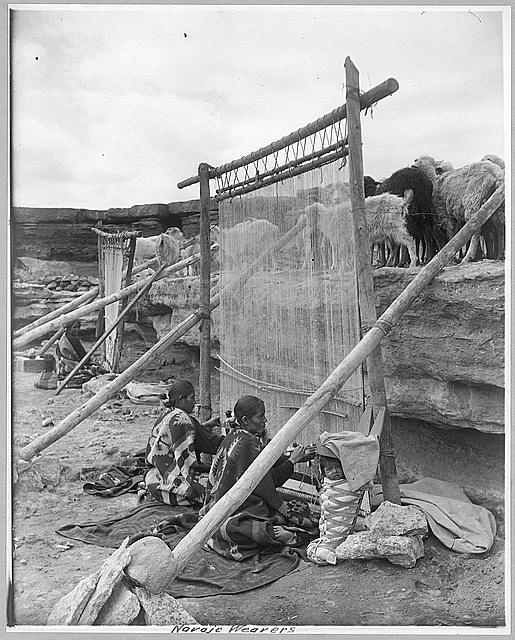
Based on my reading, it seems well understood that the Pueblo people were weaving centuries before the European invasion of North America. Their weavings were made from plant fibers, such as cotton and yucca, but it was not uncommon for human, dog, and wild animal hair to be incorporated, too. When Spanish settlers introduced Churro sheep to the region, wool began to replace cotton in textiles. When the Pueblo and Navajo people encountered one another during the seventeenth century, the Pueblo shared their knowledge of weaving with the Navajo.

Because the Navajo were largely nomadic, working with sheep and wool was well-suited to their lifestyle. The Navajo primarily created garments and blankets; however, in the late nineteenth century the political climate was harmful to the people and changed the purpose of their craft. This is when Navajo rugs became popular, and they remain that way today.
Danielle Hena, a curatorial intern at the Wheelwright Museum, explains that “stories, curiosities, and beauty are carried within each textile: stories from history, curiosities that will continue to be curiosities, and beauty that was transferred from a weaver’s vision to the viewers.” She perfectly sums up what makes the rich textile heritage of indigenous people so unique.
Feeling inspired? I know I am! I’d like to share an inspirational resource I uncovered while writing this post: the organization Adopt-a-Native Elder’s Rug Program. This organization facilitates a market for Navajo elders to sell their beautiful handwoven rugs. I thought this was pretty neat and I couldn’t resist sharing.
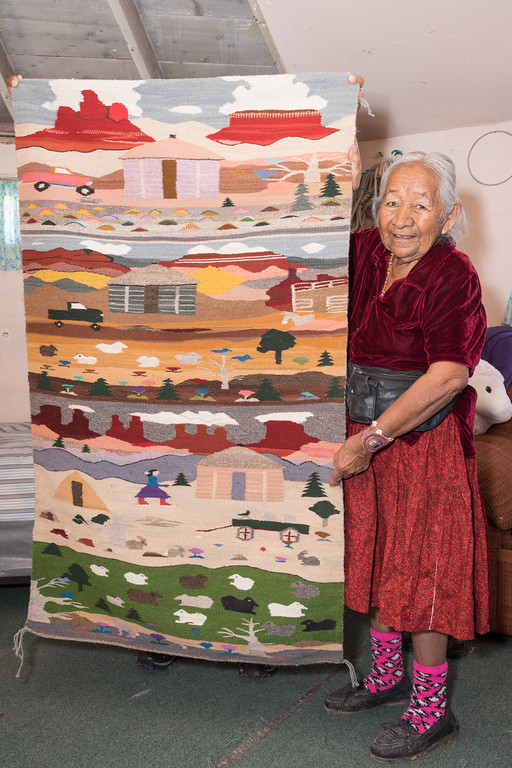
Still, if you want to make things with your own hands, there are plenty of resources out there! For example, Amy is an avid weaver and occasionally posts about the topic on our blog. You can find her weaving posts here (link). You may also be interested in a pattern – if so, check out the Sparkle Windows Scarf. This thing is gorgeous! Finally – check your local yarn shop for weaving classes. Our customers have shared projects woven using many of our yarns, and it’s such a lovely way to see it transformed.
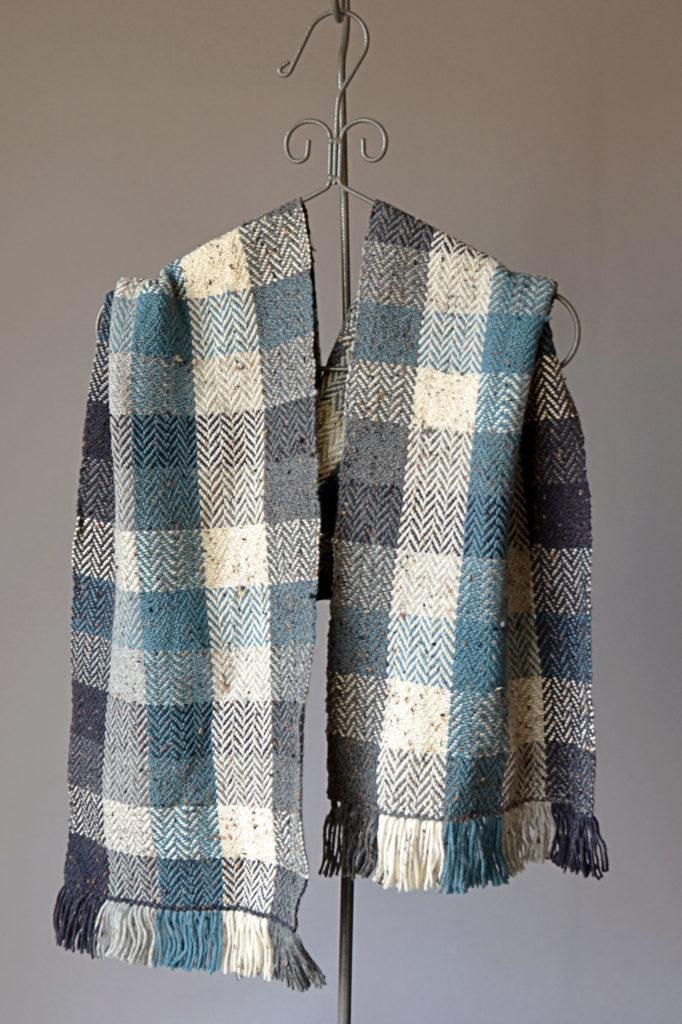
I hope you’ve enjoyed this post, have learned something from it, and feel inspired!
If you’re interested in reading more, here are the resources I’ve used for this post:
On Cowichan Knitting
Cowichan Indian Knitting by Margaret Meikle (link)
Knitting Around the World: A Multistranded History of a Time-Honored Tradition by Lela Nargi; (pp. 217-225)
Yetsa’s Sweater by Sylvia Olsen
On Weaving
For more information about Jennie Thunaut and Chilkat Blankets, I recommend exploring Masters of Traditional Arts, an ongoing interdisciplinary project produced by Documentary Arts focusing on the recipients of the National Heritage Fellowship (link here).
Unpacking a phrase: The Chilkat Blanket by Christy Christodoulides (link)
Three Southwest Weaving Cultures; adapted from Beyond the Loom: Southwestern Weaving Traditions exhibit, Colorado University Museum (link)
Wheelwright Museum Blog – Archives of Navajo Textiles (link)
This is part 12 in a 12 part series highlighting designs from our 12 Days of Winter, Series 2 Edition.
Day 12 – can you believe it? Today we reveal the final installment of the Universal Yarn 12 Days of Winter Kit Collections – Series 2! Say hello to the Solstice Shawl.
Can I be honest? I am really proud of this design – in my opinion, it’s one of my best designs and I sincerely hope you love it.
This isn’t a very complicated design, but what I feel proud of is the balance of simplicity and intricacy in the piece. This shawl combines cables, stripes, and intarsia. It is worked from tip to tip, starting and finishing with the same number of stitches (just two!). Finally, it’s finished with a very simple contrast color border.
Part of what makes this project special is the yarn used: Deluxe DK Tweed Superwash. I love this yarn. It’s rustic and the tweedy nubs add interest to every type of pattern – from simple garter to cables, lace, and stranded colorwork. (If you need convincing, just take a look at the recent collection in this yarn, Rustic & Refined).
I’m keeping this post short and sweet, but before I sign off, thank you’s are in order! Like last year we had a really wonderful time putting this collection together. It is a team effort, for sure. So thanks to everyone on our team for putting in so much hard work! And thank you so much for supporting our company, your local yarn shops, and for following our posts for this collection. We appreciate it so much!
Remember, you can find the 12 Days of Winter Kit patterns on Ravelry.
This is part 11 in a 12 part series highlighting designs from our 12 Days of Winter, Series 2 Edition.
Say hello to First Frost, an accessory set that is sure to warm you up this season!
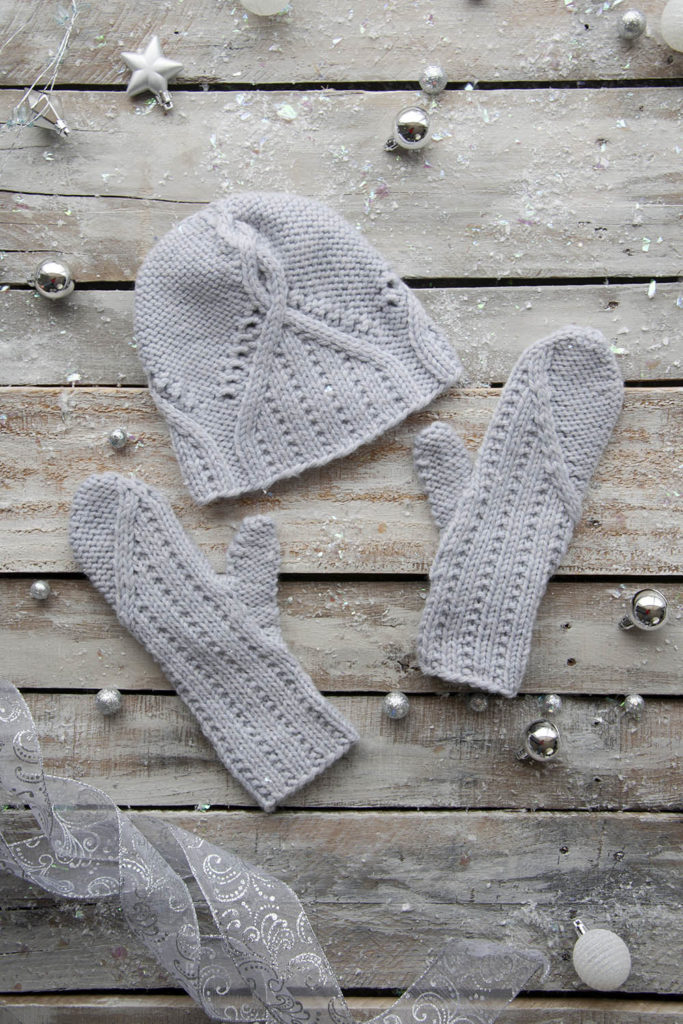
Ah, knitting. I love everything about it. However, some techniques sing to me more than others. Cables are one of those techniques. I can never get enough. If I can squeeze them in, I do. They don’t have to be complicated – but they can be. Either way, I love them. I want to knit cables as often as I want to eat Kit Kats or Reeses’ Peanut Butter Cups – all the time!
I actually really like using cable needles, but I occasionally lose them. The crevices on my sofa are likely home to several. So what do you do when you don’t have a cable needle or spare DPN handy? Do you find another project? NO! Of course not! You simply cable without a cable needle. I’m going to show you how with a quick tutorial!
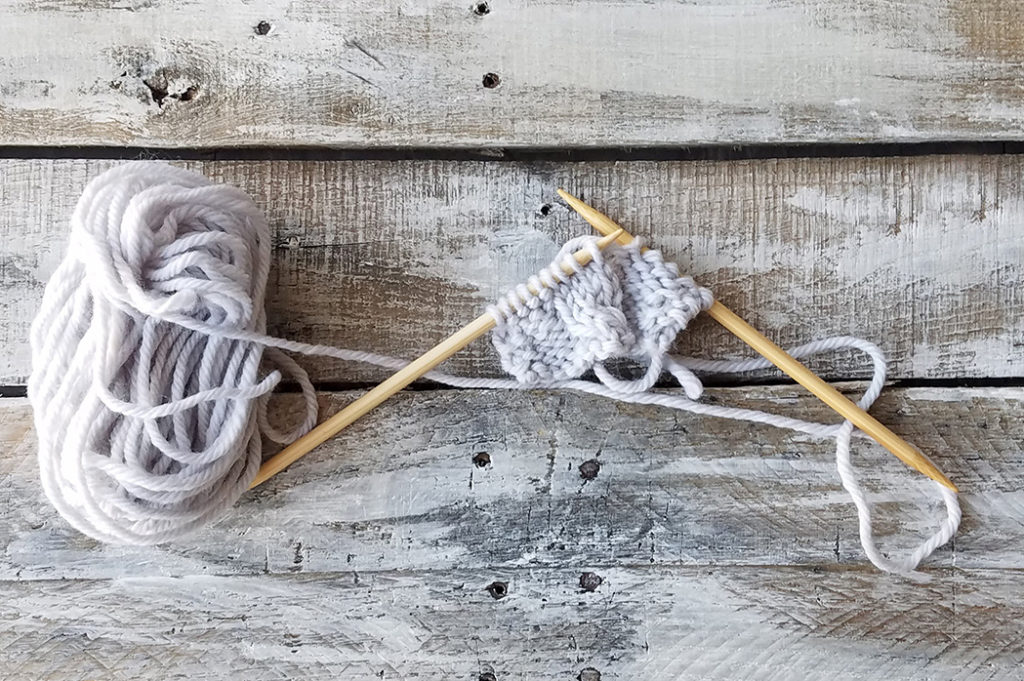
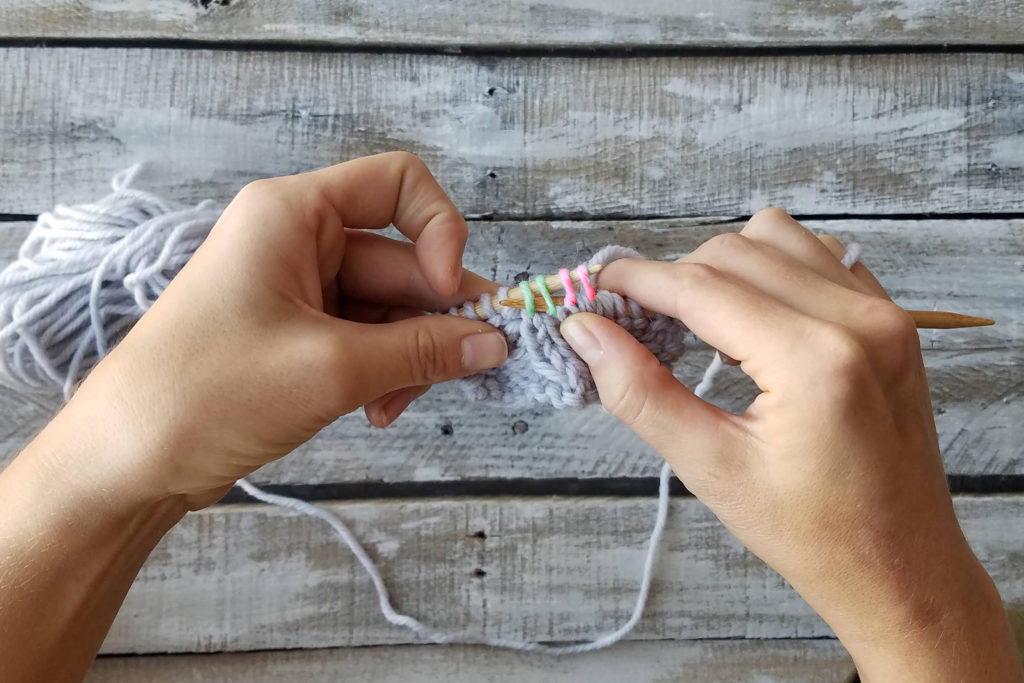
Going behind the first two stitches (red) on the left-hand needle, slip the third and fourth (green) stitches to the right-hand needle. The first two stitches will be in FRONT of the work. If you were working this as a right cross, the red stitches would be in the BACK of your work, and you would slip the green stitches purlwise from the front.
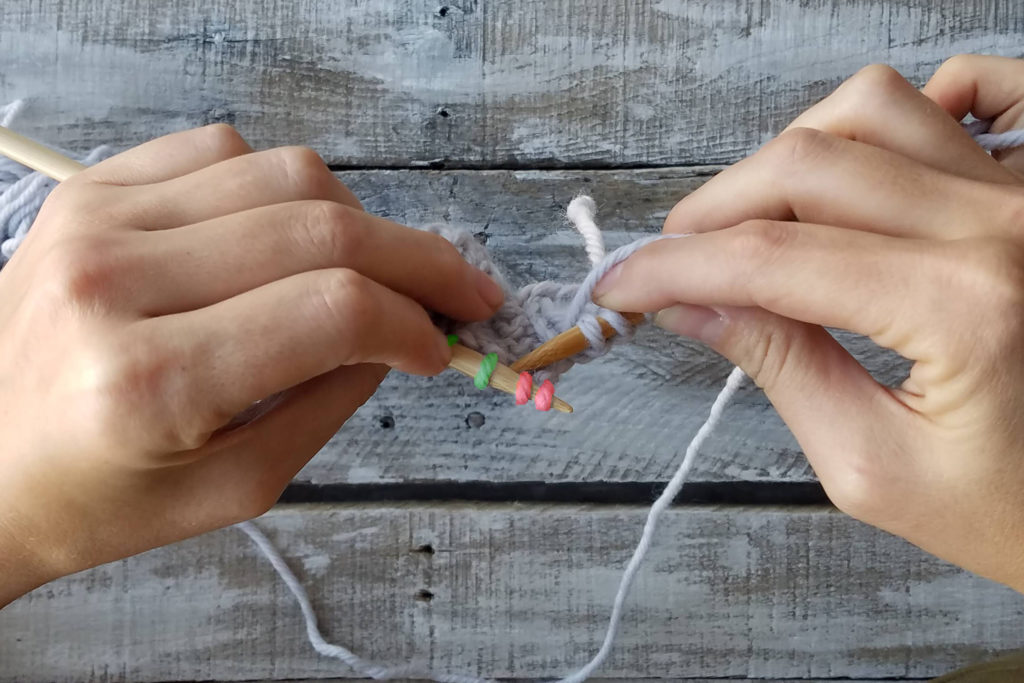
If the above photo scares you, just take a deep breath. It’s really not that scary! When you slip the green stitches, the red stitches will fall off your needle. That is okay – that’s what you want!
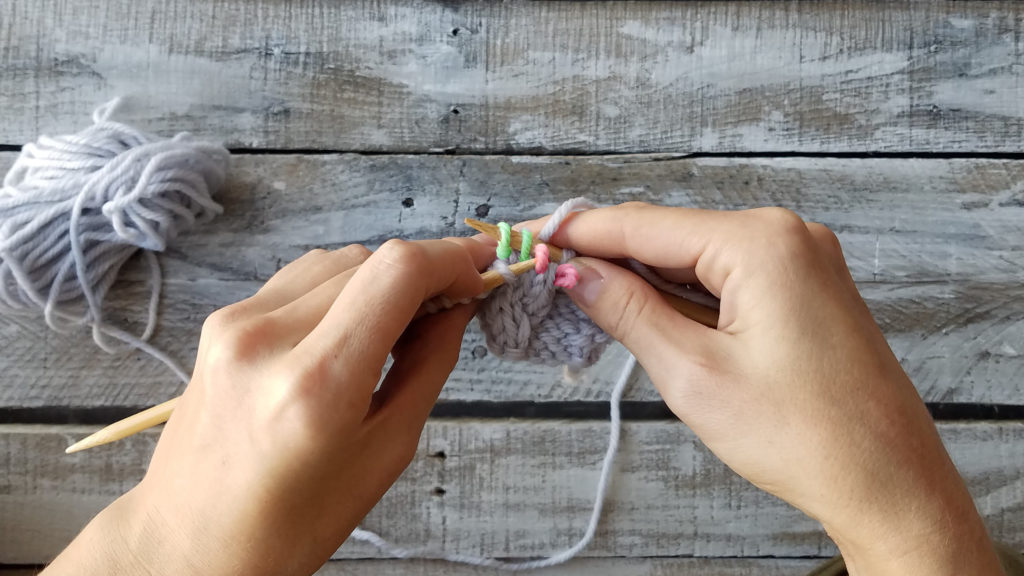
Carefully scoop the red stitches up with your left-hand needle. Breathe a sigh of relief – your stitches are safe again. Notice, we are simply re-arranging the stitches. * If you were working this as a RIGHT cross, the red stitches would be in the back of your work.
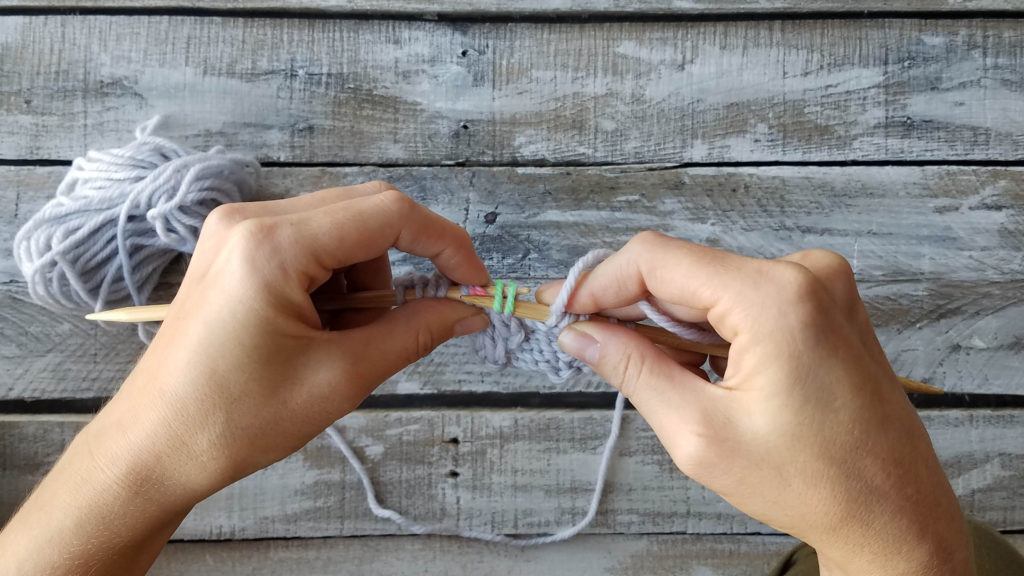
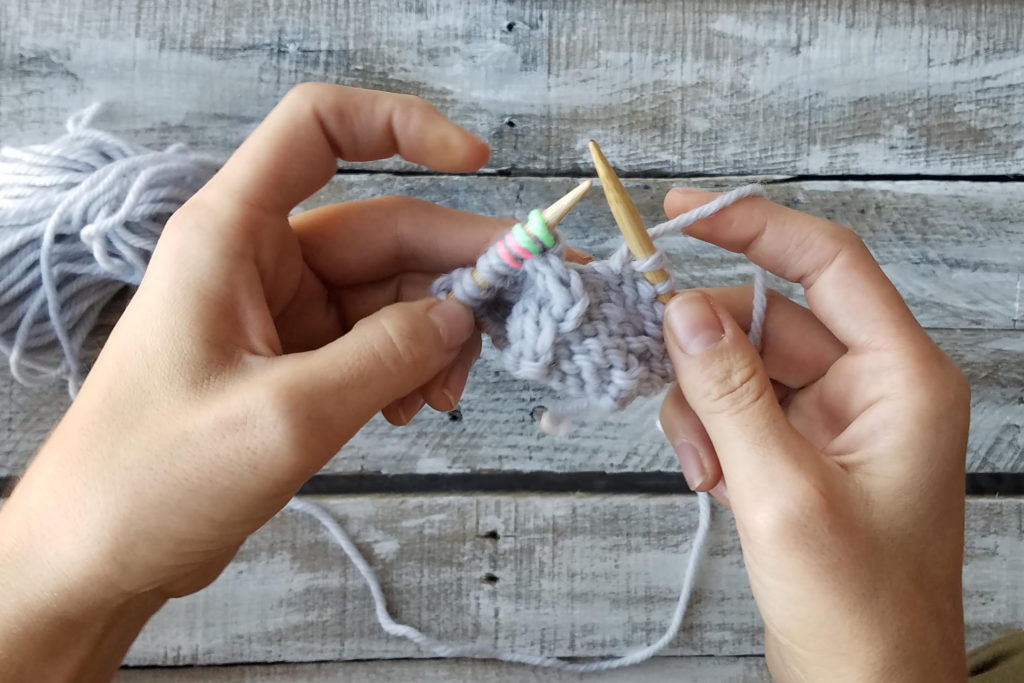
After the stitches are all back on the left-hand needle you may continue knitting as usual. You can already see the twist in your work.
That’s it! You’ve created a beautiful cable without a cable needle.
I realize that I’ve only included instructions for a 2×2 Left Cross here, but my hope is mainly to give you the courage to go forth without a cable needle. In fact, the pattern features left and right crosses; so if you choose to skip the cable needle you’ll have plenty of time to practice both.
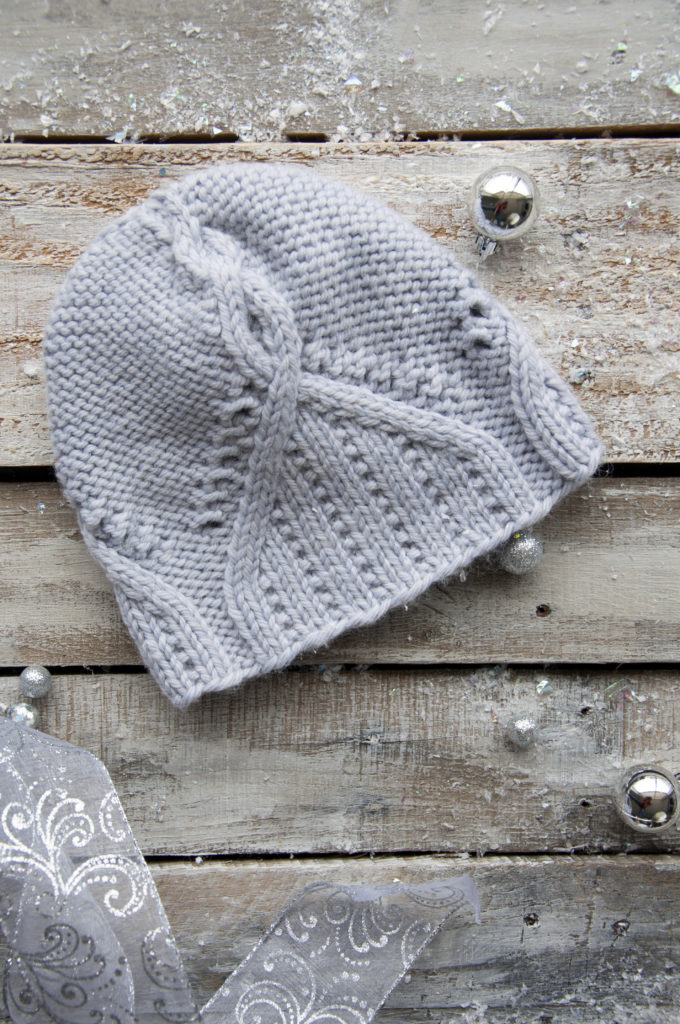
You can do this on any number of stitches, but I wouldn’t recommend working cables without a needle on anything more than 3×3 crosses. Any bigger than that and things can start to look sloppy and feel fiddly. Cable needles are great and help to maintain an even tension, but the same results can occur without them. Some find that skipping the cable needle feels faster, too. In personal projects, I go both ways. It depends on my mood and whether I can find my cable needle!
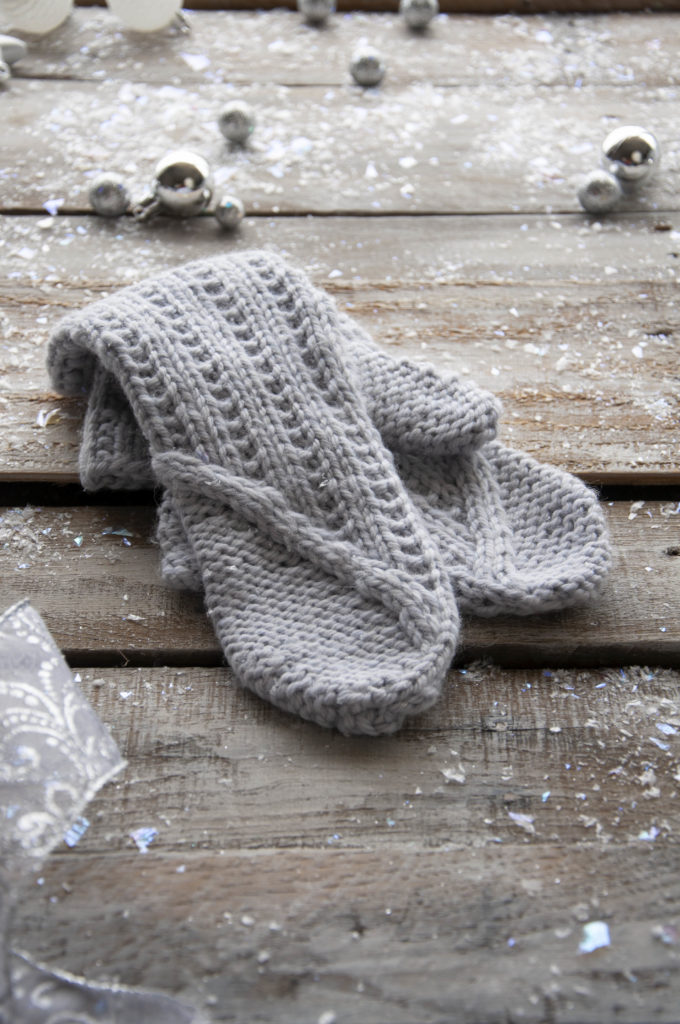
Remember, you can find the 12 Days of Winter Kit patterns on Ravelry.
It’s Free Pattern Friday!
The scarf gets its name from the plump yarn and extra-long length. Despite the length, this scarf knits up so quickly! Can you believe you only need to cast on 20 stitches?
This scarf mixes intarsia and self-striping Uptown Super Bulky Amplify for exciting results. We think this pattern is great for beginners looking to learn a new skill. Intarsia is easy, we promise!
Be careful – if your outfit matches a free pattern too closely, your colleagues may insist that you model it!
It’s okay, though! I’m totally up for wrapping myself in knitwear all day, every day! Plus, I’m almost always cold! We wrapped this scarf around my neck many times. Perfect for the snowy weather the north has been experiencing this week!
We hope you enjoy this week’s free pattern! Have a fabulous weekend!
This is part 8 in a 12 part series highlighting designs from our 12 Days of Winter, Series 2 Edition.
Say hello to the Glisten Cowl (link here). Winter, more than most seasons, elicits a desire to adorn ourselves with something sparkly. It’s probably because of all the bright lights, the glow of snow, and – as my dear friend Yukon Cornelius puts it: “gold; and silver!” So if you’re in the mood for sparkly seasonal splendor, I invite you to treat yourself to the Glisten Cowl.
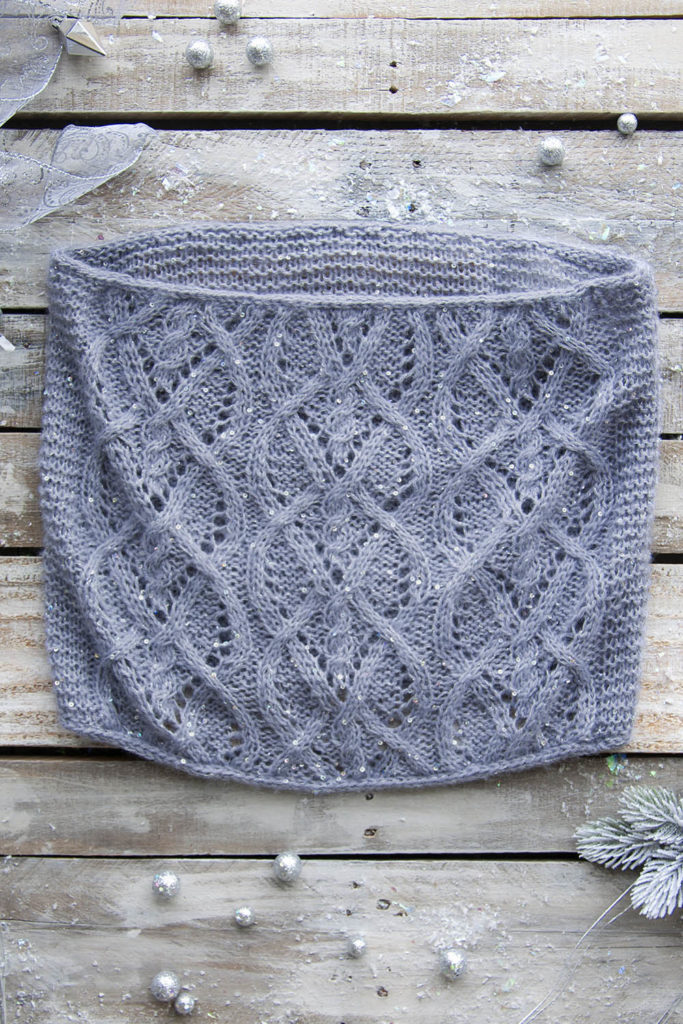
The yarn is what truly makes this design special. Amphora and Cotton Gold are held together to create a fabric with a soft halo and radiant sparkle. It’s perfect for every special holiday event you attend.
The front part of the cowl is an intriguing cable and lace pattern, while the back is simple garter stitch. The garter section allows your mind to rest before diving back into the patterned section. The difference between the two sections is also visually pleasing allowing the intricate cables to shine more brightly.
The popular winter carol – Winter Wonderland – inspired the name of this cowl, so it’s only fitting that a knitters’ version of the song exists. I struggled a bit and recruited Heather’s talent for words. Get ready because it’s pretty amazing. I’m only sorry that we don’t have a recorded version of her singing it – I learned today that she has a lovely singing voice!
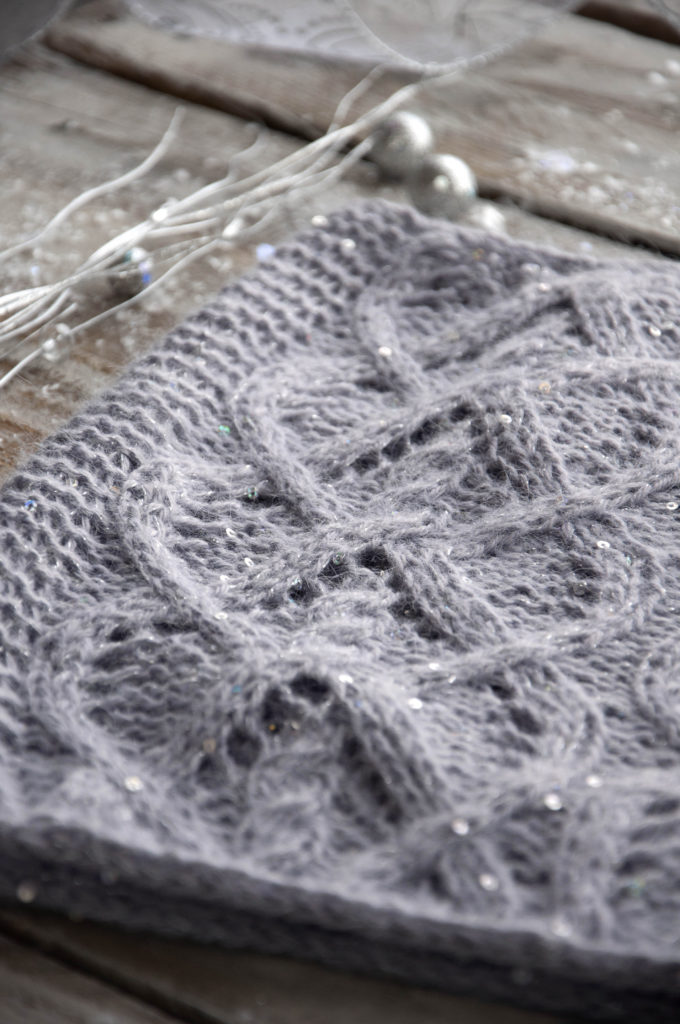
Winter Wonderland – Knitters Edition
Needles click, are you listening
You can see this cowl glistening
A beautiful sight
We’re happy tonight
Knitting in a winter wonderland
We make sure, to do swatching
So our gauge, we’re not botching
Our tension’s not wrong
As we finally cast on
Knitting in a winter wonderland
In the meadow, we can knit a snowfolk
Then pretend she runs our LYS.
She’ll say, “did you mean to drop that stitch, dear?
Don’t you fret a bit,
I’ll fix your mess!”
Later on, we’ll admire
As we knit by the fire
The cowl that we’ve made
In just the right shade
Knitting in a winter wonderland.
Three cheers for Heather – she’s an invaluable part of our team!
Remember, you can find the Series 2 12 Days of Winter Kit Patterns on Ravelry.
This is part 5 in a 12 part series highlighting designs from our 12 Days of Winter, Series 2 Edition.
Meet your new best friends: the Snowfolk (pattern link)! Agnes, Dorothy, and Maureen are a trio of knitters made from Deluxe Worsted. I love this yarn because it’s great for so many things – garments, accessories, home decor – you name it, Deluxe Worsted has you covered! This group of frosty friends is a joy to make, and you’ll have plenty of yarn to make more than three. We encourage you to have fun customizing your very own wintry knitting circle!
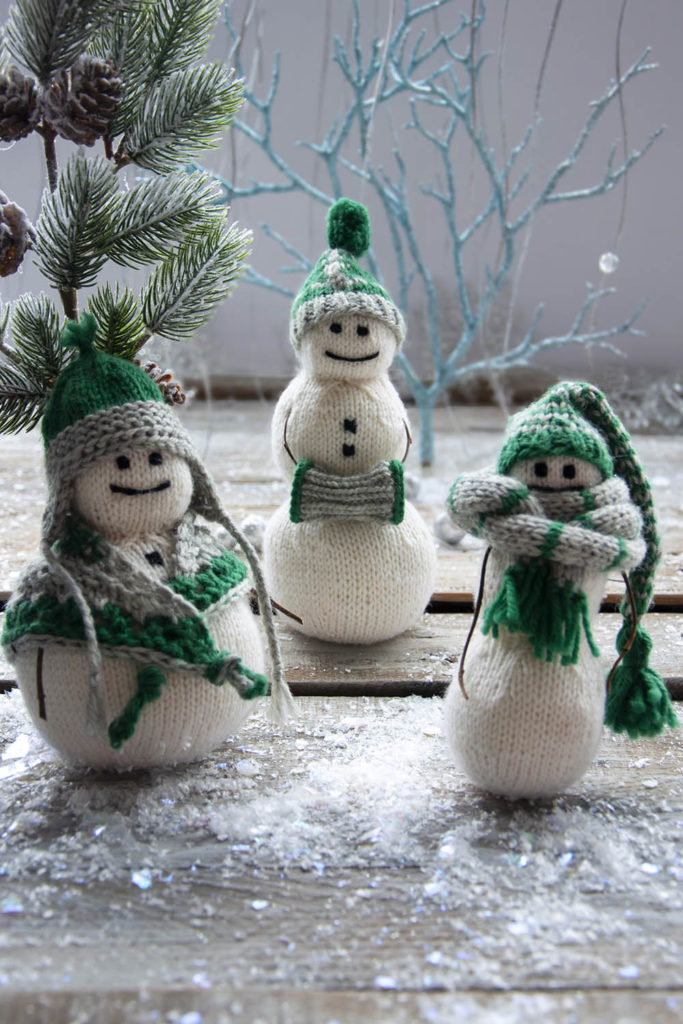
Snowfolk is a collaboration between Amy (our amazing creative director) and myself (Rachel – Amy told me to add that I am also amazing). Between the three snowpeople we designed and the collaboration involved in this pattern (not to mention by our entire team who have made this collection possible), I started thinking about knitting in the company of others. I asked some of my colleagues what their favorite things about knitting with others are.

Here is what Amy had to say:
“I travel to a lot of knitting shows, and so I find myself knitting amongst strangers (or friends) quite often at these events. I love how this one thing that we have in common paves the way for such a strong bond between people. I have made many dear friends through knitting.”
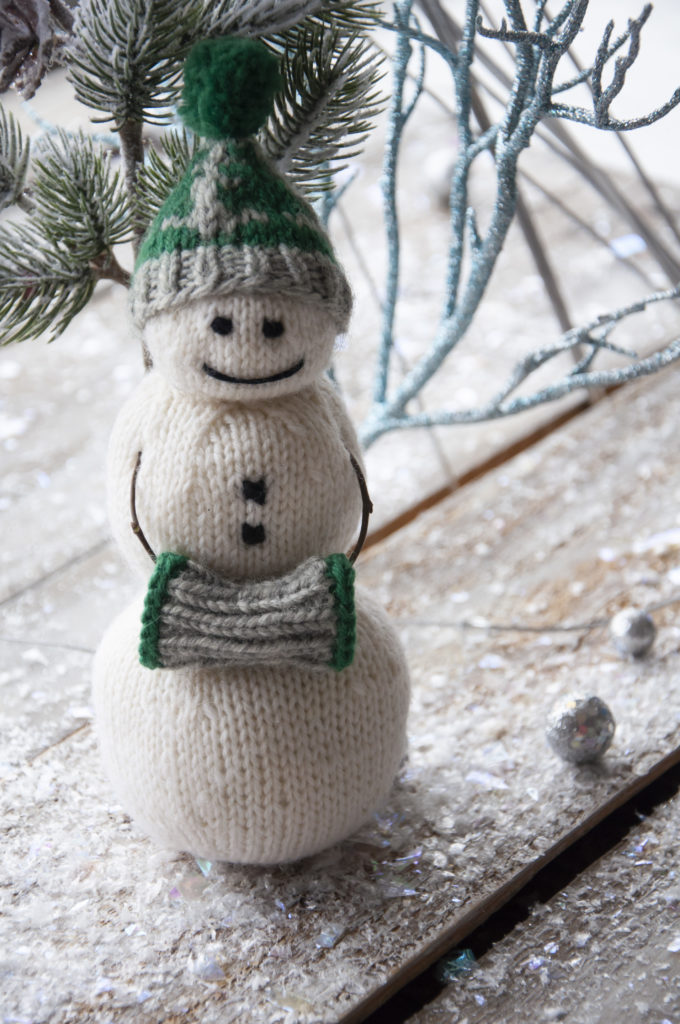
Heather told me:
“My weekly knitting group is a great way to decompress. I can share my worries with sympathetic people while also doing something soothing. Dropping in my with local knitting group has brought me lifelong friends – and a cat when a knitting buddy needed to move!”
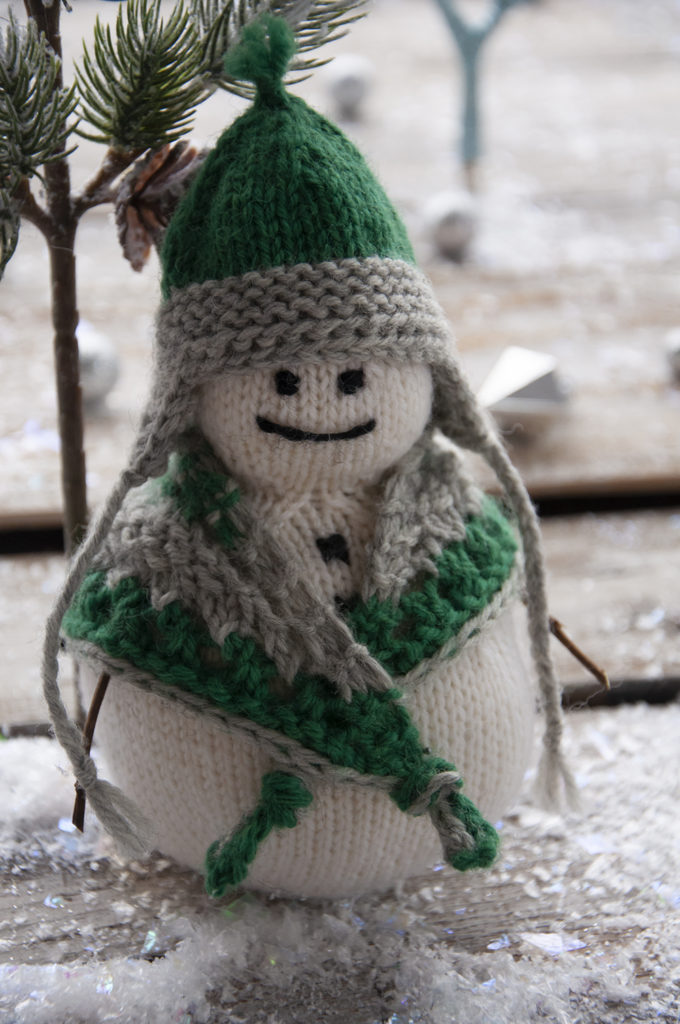
Most of the time I’m someone who revels in knitting at home in the company of my pets, but there is something so nice about knitting with friends or seeing someone you don’t know knitting in public. That commonality often creates an instant bond. I love visiting my local yarn shop to catch up with the owner and her employee as I pass stitches from one needle to the other. Once or twice a year I treasure the moments when I can join one of my dearest friends in person to gush about what we’ve been knitting. A great friend who lives nearby joins me each week to knit and chat. If I’m honest, I don’t accomplish much when knitting with others! I may get through a few rows, but spending that time with those I care about while doing something we love is what’s truly special.
What do you love about knitting with others? Do you have a weekly knitting circle? Maybe you love attending shows. We’d love to hear about it!
Remember, you can find Series 2 of the 12 Days of Winter Kit patterns on Ravelry.